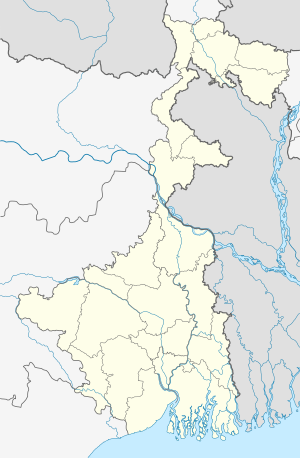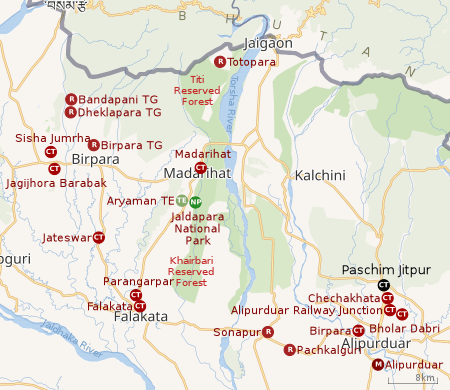Paschim Jitpur
Paschim Jitpur is a census town in the Alipurduar I CD block in the Alipurduar subdivision of the Alipurduar district in the Indian state of West Bengal.
Paschim Jitpur | |
|---|---|
Census Town | |
 Paschim Jitpur Location in West Bengal, India  Paschim Jitpur Paschim Jitpur (India) | |
| Coordinates: 26.55601°N 89.53493°E | |
| Country | |
| State | West Bengal |
| District | Alipurduar |
| Area | |
| • Total | 6.32 km2 (2.44 sq mi) |
| Population (2011) | |
| • Total | 14,334 |
| • Density | 2,300/km2 (5,900/sq mi) |
| Languages | |
| • Official | Bengali, English |
| Time zone | UTC+5:30 (IST) |
| Vehicle registration | WB |
| Lok Sabha constituency | Alipurduars (ST) |
| Vidhan Sabha constituency | Alipurduars (ST) |
| Website | alipurduar |
Geography
 |
| Places and tea estates in the western portion of Alipurdar subdivision (including Madarihat-Birpara, Falakata and Alipuduar I CD blocks) in Alipurduar district CT: census town, R: rural/ urban centre, N: neighbourhood, NP: national park/ wildlife sanctuary, TE: tea estate Abbreviations used in names – TG for Tea Garden (town/village), TE for Tea Estate Owing to space constraints in the small map, the actual locations in a larger map may vary slightly |
Location
Paschim Jitpur is located at 26.55601°N 89.53493°E.
Area overview
Alipurduar district is covered by two maps. It is an extensive area in the eastern end of the Dooars in West Bengal. It is undulating country, largely forested, with numerous rivers flowing down from the outer ranges of the Himalayas in Bhutan. It is a predominantly rural area with 79.38% of the population living in the urban areas. The district has 1 municipal town and 20 census towns and that means that 20.62% of the population lives in rural areas. The scheduled castes and scheduled tribes, taken together, form more than half the population in all the six community development blocks in the district. There is a high concentration of tribal people (scheduled tribes) in the three northern blocks of the district.[1][2][3]
Note: The map alongside presents some of the notable locations in the subdivision. All places marked in the map are linked in the larger full screen map.
Demographics
According to the 2011 Census of India, Paschim Jitpur had a total population of 14,334 of which 7,189 (50%) were males and 7,145 (50%) were females. There were 1,302 persons in the age range of 0 to 6 years. The total number of literate people in Paschim Jitpur was 11,146 (85.53% of the population over 6 years).[4]
As of the 2001 India census,[5] Paschim Jitpur had a population of 13,389. Males constitute 51% of the population and females 49%. Paschim Jitpur has an average literacy rate of 70%, higher than the national average of 59.5%: male literacy is 77%, and female literacy is 64%. In Paschim Jitpur, 11% of the population is under 6 years of age.
Infrastructure
According to the District Census Handbook 2011, Jalpaiguri, Paschim Jitpur covered an area of 6.32 km2. Among the civic amenities, it had 15 km roads, with both closed and open drains, the protected water supply involved overhead tank, hand pump. It had 1,900 domestic electric connections. Among the medical facilities it had 3 dispensaries/ health centres, 10 medicine shops. Among the educational facilities it had 8 primary schools, 1 middle school, 1 secondary school, 3 senior secondary schools, the nearest general degree college at Alipurduar 2.5 km away. It had 1 recognised shorthand, typewriting, vocational training institute, 1 non-formal education centre (Sarva Siksha Abhiyan). Among the social, cultural and recreational facilities it had 1 public library.[6]
References
- "District Statistical Handbook 2014 Jalpaiguri". Tables 2.2, 2.4b,. Department of Planning and Statistics, Government of West Bengal. Retrieved 29 June 2020.CS1 maint: extra punctuation (link)
- "CD block Wise Primary Census Abstract Data(PCA)". 2011 census: West Bengal – District-wise CD blocks. Registrar General and Census Commissioner, India. Retrieved 29 June 2020.
- "District Census Handbook, Jalpaiguri, Series 20, Part XIIA" (PDF). Census of India 2011, page 13 Physiography. Directorate of Census Operations, West Bengal. Retrieved 18 June 2020.
- "2011 Census – Primary Census Abstract Data Tables". West Bengal – District-wise. Registrar General and Census Commissioner, India. Retrieved 26 June 2020.
- "Census of India 2001: Data from the 2001 Census, including cities, villages and towns (Provisional)". Census Commission of India. Archived from the original on 16 June 2004. Retrieved 1 November 2008.
- "District Census Handbook Jalpaiguri, Census of India 2011, Series 20, Part XII A" (PDF). Section II Town Directory, Pages 451-453: Statement I: Status and Growth History, Pages 454-455: Statement II: Physical Aspects and Location of Towns, Pages 456-457: Statement III: Civic and other Amenities, Pages 458-459: Statement IV: Medical Facilities 2009, Pages 460—463: Statement V: Educational, Recreational and Cultural Facilities, Pages 464: Statement VI:Industry and Banking. Directorate of Census Operations V, West Bengal. Retrieved 26 June 2020.